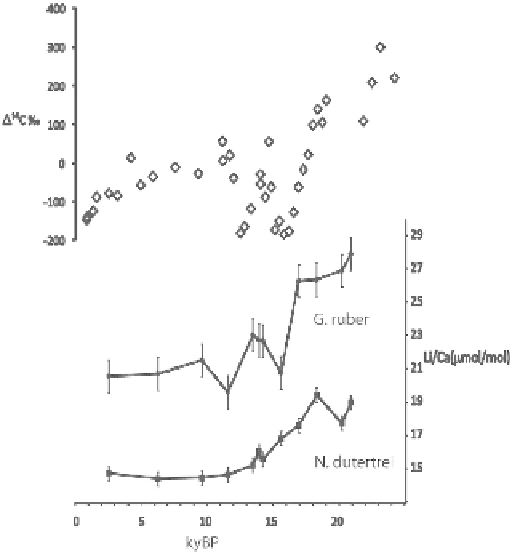Geoscience Reference
In-Depth Information
cant increase in CO
2
storage (and reduced CO
2
fluxes) during glacials and a
production rate of CO
2
suf
Our hypothesis requires a signi
14 kyr B.P. was not recorded in Paci
c Deep Water (Fig-
14
C record from MD9821-81 implies
14
C-depleted carbon entering the surface ocean during the
MI was highly diluted by the time it mixed with Paci
ure 3). The benthic
Δ
cient to replenish the CO
2
re-
leased during deglaciations. This requirement has an impor-
tant implication for current estimates of volcanic-derived
CO
2
in the global carbon cycle budget. If correct, this hy-
pothesis requires an upward adjustment in the relative con-
tribution of CO
2
from submarine volcanism [Lupton et al.,
2006]. We use a one-dimensional, three-box carbon cycle
box model to estimate the amount of CO
2
required to explain
a 50 ppm rise in atmospheric CO
2
over 5 kyr during the MI.
The box model simulates exchange of carbon between the
atmosphere and the shallow, intermediate, and deep ocean
reservoirs [Tyrell et al., 2007]. This model simulates a release
of carbon directly to the atmosphere and subsequent equili-
bration with the entire ocean. The model simulates a scenario
similar to that which we propose in which carbon is released
from shallow to intermediate depths (<1000 m) and venti-
lates more or less directly to the atmosphere. The model does
not simulate carbon exchange with terrestrial reservoirs and
parameterizes carbon, phosphorous, and alkalinity
c Deep
Water. A mass balance that does not take into account the
differences in
14
C between surface and deep water during
the MI would greatly overestimate the amount of carbon that
entered the ocean. Thus far, a
Δ
Δ
14
C excursion during the MI
has only been documented in surface ocean records and from
benthic foraminifera that inhabited water depths between
~500 and 700 m. We therefore conclude that the amount of
14
C-dead carbon released during the MI was substantially
less than 5000 Gt if it was released from shallow water
depths and entered the atmosphere before equilibrating with
the entire deep ocean.
A transient release of CO
2
to the atmosphere during the
MI as we hypothesize would have caused a simultaneous
adjustment in the carbonate ion concentration of surface
waters. We have constructed a preliminary Li/Ca record
through the MI from two planktonic foraminifer species
taken from the Galapagos core VM21-30, Globigerinoides
uxes.
For our simulation, we hold phosphorous and alkalinity
fluxes constant and impose a transient flux of carbon over
5000 years.
Between 19 and 14 kyr B.P., the concentration of atmo-
spheric CO
2
increased by approximately 50 ppm. In the box
model, a transient 50 ppm increase in atmospheric CO
2
over
5000 years requires a release of 600 Gt of carbon to the
atmosphere. As the carbon enters the atmosphere, CO
2
re-
equilibrates with the ocean, a process that takes several
thousand years. The transient release of 600 Gt of C to the
atmosphere increases atmospheric pCO
2
by 45
-
50 ppm for
roughly 7
10 kyr B.P., the length of an entire interglacial,
and then gradually decays back to lower concentrations as
the CO
2
equilibrates with the deep ocean reservoir. The 600
Gt of carbon would be equivalent to ~2200 Gt of CO
2
.
The box model simulates a rise in atmospheric CO
2
that is
consistent with ice core records. However, 600 Gt of
14
C-free
carbon released to the atmosphere would not shift
-
14
Cof
Δ
carbon throughout the deep ocean by
[Broecker,
2009a]. In order to shift the deep ocean reservoir of carbon
by
190
‰
along with the atmosphere and surface ocean
would require nearly 5000 Gt of
14
C-free carbon. On the
other hand, there are not many well-calibrated, high-resolution
Δ
190
‰
14
C records for the deep ocean that span the MI. Hence, we
do not know if the entire deep ocean carbon reservoir also
decreased by
190
‰
between 17.5 and 14 kyr. Taking
planktonic and benthic foraminiferal
14
C ages from sediment
core MD9821-81, (6°N, 126°E, 2.1 km water) as estimators
of surface and deepwater
Δ
14
C for benthic foraminifera from Baja margin
core MC19/GC31/PC08 [Marchitto et al., 2007] and (bottom) Li/Ca
for two species of planktonic foraminifera, Globigerinoides ruber,
and Neoglobquadrina dutertrei from Galapagos margin core VM21-
30 (K. Harazin and L. Stott, manuscript in preparation, 2011). Error
bars on Li/Ca are standard deviations of replicate measurements of a
sample.
Figure 4.
(top)
Δ
14
C values through the last glacial
termination suggests the
190
‰
decline between 18 and










Search WWH ::

Custom Search